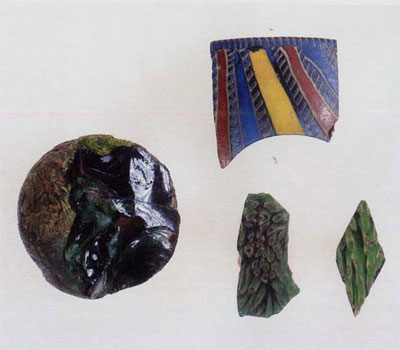
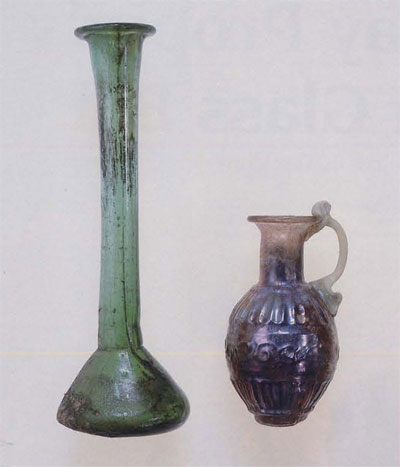
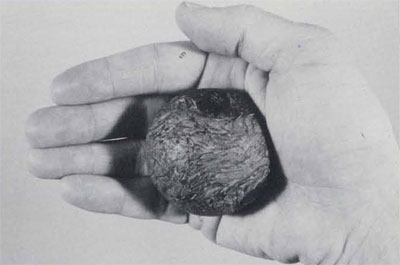
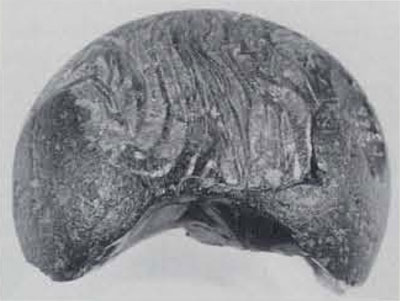
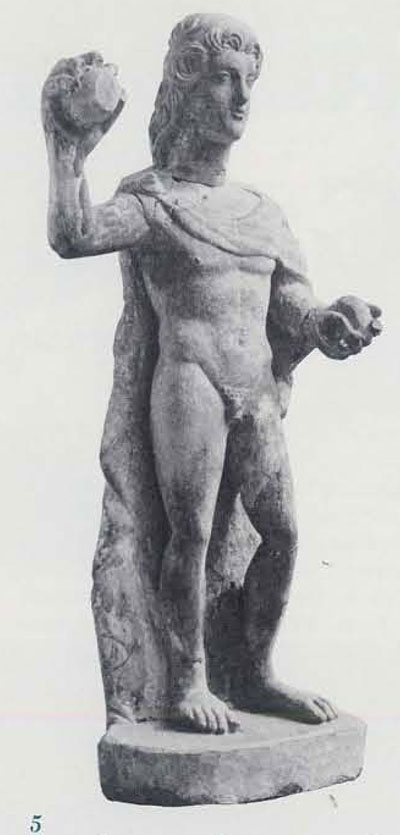
A curious glass ball (Figs. 1, 3, 4) housed in the Mediterranean Section of The University Museum helps us to understand one aspect of Roman sport, and at the same time sheds light on the activities of the lower classes of Roman society. The interpretation of this artifact is based on two 1st century A. D. poets and on a 2nd century A. D. tombstone.
The glass ball was donated to the Museum in 1916 by Miss L. T. Morris as part of the Thompson bequest, a number of antiquities that Miss Morris and her brother, Mr. John Thompson Morris, had collected in Greece, Egypt, and elsewhere. The ball is spherical, measuring 5.5 centimeters in diameter, and is broken on one side (Fig. 1).
While perhaps it is regrettable that the ball is not in its pristine state, the break is in fact fortunate because it enables us to see how the ball had been manufactured. It is entirely composed of re-melted cullet (pieces of broken glass), most of which is the green type that is the most commonly used in early blown glass. The color results from the naturally occurring presence of small amounts of iron. Figure 2 (left) shows a typical 2nd century A. D. candlestick unguentariuin (container for oils or perfumes) in The University Museum’s collection made of the same type of glass. A small part of the ball is composed of a transparent purple glass, the same type used to form a mold-blown vessel (Fig. 2, right) of the early 2nd century A.D., also in the Museum’s collection.
A close-up examination of’ the outside of the ball shows that it is composed of a thin shell of millefiori (“thousand-flowers”) glass (Fig. :3). Most of this is formed with opaque yellow rods in a translucent green matrix, the same type of glass used to make the fragments shown on the lower right in Figure 1, a piece of a plate and a diamond-shaped tessera (piece of a mosaic). On the outside of the ball there is also a small bit of a twist composed of opaque white and translucent blue trails, a common feature of the rims and bodies of mosaic glass vessels (see Fig. 1, upper right). The green matrix millefiori glass and the blue and white twist mosaic glass are of types that can he dated to the mid-1st century A. D.
What are we to make of this curious object? One clue comes from the 1st century A. D. poets Martial and Statics, both of whom mention the poor folk who trade sulphur fin-broken glass:
What are you then? You are a buffoon, just like the wandering hawker from across the Tiber, who exchanges brimstone matches for broken sherds of glass.
quid ergo? verna, hoc quad T tiberinus ambulator, qui pallentia sulpurata fracas permutat vitreis.Martial, Book I, chapter 41, lines 2-5
Here ripe Lydian girls are clapping, there tinkle cymbals from Cadiz, there Syrian troops raise a roar, here are plebians from the theater and those who exchange common sulphur for broken glass.
Hoc plaudunt grege Lydiae tumentes, illic cymbala tinnulaeque Gades, illic agmina confremunt Syrorum, hic plebs scenica quique comminutis permutant vitreis gregale sulpur.Statius, Silvae, Book I, chapter vi, lines 70-74
One scholar has suggested that glass makers cut tesserae for mosaics out of the cullet brought in by the hawkers (Smyth 1947:46-47). Indeed, cut glass squares like MS 545 (Fig. 1, lower right) are examples of this practice. Objects like the Museum’s glass ball were also products of this early recycling. Moreover, we should note that the glass ball was produced by a skilled glass worker. The technical feat of fusing together several different types of glass into a perfectly round ball would pose difficulties today.
The glass ball in The University Museum is not unique. There is a similar ball in Düsseldorf that is slightly smaller and has both opaque yellow and red rods in its millefiori glass covering (Heinemeyer 1966: 20). The two glass balls could easily have been made by the same craftsman.
What, then, were these small balls used for? Again we can get a clue by turning to the abundant written records of the Romans. This time a 2nd century A. D. epitaph tells us how a glass hall may have been used:
Ursus, the first Roman citizen to play properly with a glass ball with my players, to the great clamoring of the approving crowd in the baths of Trojan, Agrippa and Titus and especially in the baths of Nero; if you still believe me—that’s me!
Ursus, togatus vitrea qui primus pila lusi decenter cum meis lusoribus, laudante populo maxim’s clamoribus thermis is Traiani, thermis Agrippae at Titi multum et Neronis, si tamen mihi creditis ego sum.
—CIL Vol. 6, Inscription 9797, lines 1-6
One of the favorite ball games that Romans played in the baths was trigon,a sort of three-man juggling act where the players toss balls back and forth as quickly as they can. (For more on this game, see Donald White’s article in this issue.) Our glass ball fits neatly in the palm of a hand (Fig. 4) and would have made an excellent trigon ball. There would have been no danger of the solid ball breaking if dropped onto the sand of the ball-court in the baths.
There is a remarkable marble statue (Fig. 5) found by George McFadden in what may have been a palaestra at The University Museum’s excavation at the Apollo Hylates sanctuary at Kourion, Cyprus.
This statue, which dates to before the A.D. 365 earthquake, is of a youth wearing a cloak and holding two balls in his left hand and one in his upraised right hand. The statue may represent a man playing trigon (Jensen 1984).
The balls in Dusseldorf and in Philadelphia are ancient sham s — their cheap reused glass interiors were covered by a thin shell of expensive-looking millefiori glass. Perhaps they were the personal trigon balls of boastful Ursus or some other urbanite, such as that big braggart Trimalchio, who Petronius describes as bringing with him into the baths a slave boy with a bag of balls so that Trimalchio need not stoop to retrieve a dropped ball (Petronius, Satyricon 27; quoted in White’s article in this issue). Petronius may well have been referring to millefiori glass balls since he describes Trimalchio’s trigon ball as leek-green, the same color as the balls in Philadelphia and Dusseldorf.
This unusual glass object in The University Museum sheds new light on our picture of Roman society. The glass ball was made from cullet collected by poor street people, and refashioned by skilled workers into pretty baubles that were purchased by refined Roman gentlemen who knew how “to play properly” at their games in the baths.
